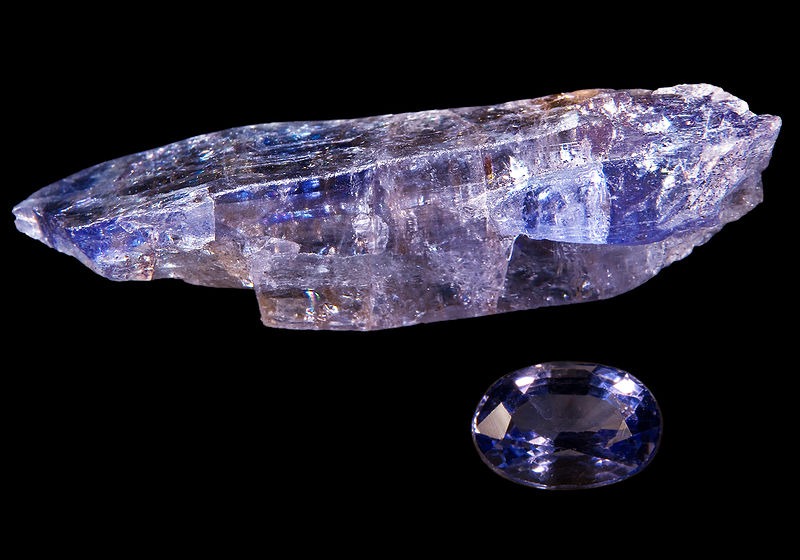History
Tanzanite is a member of the mineral family epidote. It is a calcium aluminum hydroxyl sorosilicate mineral called zoisite that is colored blue and violet and is brought on by trace levels of vanadium.
Following the discovery of this mineral in the Saualpe Mountains of Carinthia, Austria, by the Austrian scientist Baron Siegmund Zois von Edelstein, this mineral family was given the name zoisite in 1805.
According to the crystal orientation, tanzanite exhibits a remarkable amount of trichroism, appearing alternately in blue, violet, and burgundy. When viewed in various lighting situations, it can also appear differently.
Tiffany & Co. named the gemstone “tanzanite” after Tanzania, the nation where it was discovered. Massive plate tectonic activity and extreme heat in the region that eventually became Mount Kilimanjaro caused it to originate some 585 million years ago during the mid-Ediacaran Period.
Where is it mined?
Tanzania is the home of tanzanite from deep within Tanzania’s Mount Kilimanjaro foothills. There may have been two million carats of tanzanite mined in Tanzania since the mineral’s discovery in 1967 until the mines were nationalized by the Tanzanian government.
The Tanzanian government separated the tanzanite mining region, which was only two kilometers broad and four kilometers long, into four portions in 1990. Pegmatitic veins that have fractured into smaller pieces due to stress are known as boudins. Boudins are formations of tanzanite that resemble sausages
Tanzanite in Jewelry
Tanzanite was especially valued by Tiffany & Co. for use in jewelry. We all know that wearing gemstone near to our skin is a great way to maximize its benefits. It can be any form of jewelry, such as rings, necklace and earrings.
Nothing can obstruct or stop the flow of vibrational energy when healing stones are in contact with the skin. Tanzanite can be worn as a pendant to encourage the stone to remain in close proximity to the throat and eliminate any obstructions that might accumulate there.
A tanzanite bracelet assists the gem being pushed on the pulse, which sends ripples of healing intention throughout the entire body. Additionally, wearing tanzanite earrings can keep you in touch with your own inner wisdom.
Tanzanite and amethyst together make up the entire block of the higher chakras. Amethyst has purifying energy for the top chakra and shares Tanzanite’s tranquility. Along with zircon, turquoise, and blue topaz, tanzanite is a birthstone for the month of December.
Other Usage
Tanzanite can benefit a person’s life in a variety of ways. It has the capacity to change negative into positive energies. Instead of striving to fit in or being affected by others, it helps you manifest who you are. It is well known to change its colors when viewed at various angles or lightings. It has been claimed that color shifting helps people become more conscious.
It’s a stone for highly evolved individuals who haven’t yet acknowledged their power and have scared closed their hearts to it. As a result, trust is built, and we progressively become more receptive to new options.
It works wonders as a detoxifier. Tanzanite is an excellent aid in promoting stress or severe sickness recovery. The immune system is boosted and the cells are renewed. It can also reduce inflammation and balance excessive acidity. In addition to promoting fertility, tanzanite also treats ovarian and testicular disorders.
On the other hand, tanzanite is beneficial at your house or workplace. The Tanzanite stone can be positioned in any area that needs tranquility, calm, and space for introspective prayer and thinking in Feng Shui. It promotes fellowship and conversation. It gives comfort, light, and an extremely alluring brilliance.
Facts about Tanzanite
- Tanzania is the exclusive source of tanzanite mining.
- The first tanzanite was found in 1967.
- It is commonly blue in color.
- Formed approximately 585 million years ago.
- There is only one tanzanite in the world for every thousand diamonds.
- In 2020, the largest rough tanzanite was discovered.
- Valued according to the intensity of its color: the more valuable the tanzanite, the more intense the color.
- Referred to as “the most exquisite blue gemstone found in the last 2000 years.”
- It is the birthstone for those who are born in December.
- The trichroism in tanzanite makes it uncommon.
- Regarded as the customary 24th wedding anniversary gift.
- Made from calcium aluminum hydroxyl silicate.
- Tanzanite blue will be highlighted by cold light, while warm lighting will make it appear more violet-to-purple.
- Ordinary chemicals, heat, and light do not harm tanzanite.
Value
Based on weight, Tanzanite’s price and value are constantly changing. Tanzanite is a great investment stone because of the changes in its price. A carat of brilliantly colored AAA Tanzanite is worth between $200 and $350. The cost per carat for 2ct sizes is $400–550. Up to 3 carats will cost between $500 and $675 per carat. Since most Tanzanite is heated, natural purple and blue Tanzanite is the most valuable.
Wrapping it up
One of the stones that are most in demand today is tanzanite. In fact, it has surpassed the “big four,” which include emeralds, sapphires, rubies, and diamonds, in terms of popularity. This stone hasn’t been duplicated or synthesized because it’s quite new and has a short history.
Because the fire factor of tanzanite, particularly that of the brilliant blue hue, is rather high, it is the only member of the zoisite family that can be compared to other magnificent gems. When setting or handling a tanzanite, caution must be exercised.
Tanzanite is a very expensive gem, and tanzanite rings, necklaces, and earrings have become investment pieces that increase in value annually. With its beneficial use to human, surely a purchase of this gemstone will be worth thy penny.
It’s never too late to include tanzanite in your gemstone collection while it’s still available at a lower price given that tanzanite reserves are expected to be fully depleted in the following decades, the cost of this gemstone is expected to soar in the near future.


